Ais Channel
-
- AIS: T h e Future is N ow Maritime Reporter, Oct 2001 #44F
The IMO deadline for fitting new ships with Automatic Identification Systems (AIS) is less than one year away. After July 1, 2002, all newbuilds over 300 grt must be equipped with an approved AIS transponder system. Leica Geosystems, one of the pioneering companies in AIS technology, recently published a 28- page book ("A Complete Guide to Automatic Identification Systems") that is loaded with useful information on AIS technology, how it works, international standards and carriage requirements.
At the Worshipping exhibition in Oslo, Leica unveiled the first fully integrated GPS/DGPS/AIS shipboard system meeting all IMO, IEC and ITU equipment specifications. The following extracts are reprinted with permission from Leica Geosystems.
What is AIS?
AIS is a shipboard broadcast transponder system in which ships continually transmit their ID, position, course, speed and other data to all other nearby ships and shoreside authorities on a common VHF radio channel. AIS is designed to operate in one of the following modes: In a ship-to-ship mode for collision avoidance As a means for coastal states to obtain information about a ship and its cargo As a traffic management tool when integrated with a Vessel Traffic System (VTS) The primary operating mode for AIS will be autonomous ship-to-ship reporting.
In this mode, each ship transmits its data to all other AlS-equipped ships within VHF range. The unique communications scheme permits these data transmissions to take place independently without the need for a master control station.
Position and other data are fed automatically from the ship's sensors into the AIS system, where the data is formatted and transmitted in a short data burst on a dedicated VHF channel. When received on the other ships, the data is decoded and displayed for the officer of the watch, who can view AIS reports from all other AlS-equipped ships within range in graphic and text format. The AIS data may optionally be fed to the ship's integrated navigation systems and radar plotting systems to provide AIS "tags" for radar targets. The AIS data can also be logged to the ship's Voyage Data Recorder (VDR) for playback and future analysis.
In coastal waters, shoreside authorities may establish automated AIS stations to monitor the movement of vessels through the area. These stations may simply monitor AIS transmissions from passing ships, or may actively poll ves- sels via the AIS channels, requesting data such as identification, destination, ETA, type of cargo and other information. Coast stations can also use the AIS channels for shore-to-ship transmissions, to send information on tides, notices to mariners and local weather forecasts. Multiple AIS coast stations and repeaters may be tied together into Wide Area Networks (WAN) for extended coverage. AIS data can be logged automatically for playback in investigating an accident, oil spill or other event.
When integrated with shore-based vessel traffic systems (VTS), AIS can augment traditional radar-based VTS installations, providing an AIS "overlay" on the radar picture, or can provide a cost-effective alternative in areas where it is not feasible to establish radar-based systems. When integrated with radar, the AIS can ensure continuous coverage, even when the radar picture is degraded by heavy precipitation or other interference.
The VTS center can assume control over the assignment of timeslots for AIS messages to ensure optimum data exchange within the coverage area. Special dedicated channels may be designated for localarea AIS operations. The shipboard AIS equipment will have the ability to shift to different channels automatically when directed by the shoreside VTS controller.
AIS Communications Scheme AIS messages must be updated and retransmitted every few seconds at a minimum, since the usefulness of the data decays rapidly as a function of time. To accommodate this high update requirement, AIS utilizes a unique self-organizing time-division multiple access (STDMA) data communications scheme, which uses the precise timing data in the GPS signals to synchronize multiple data transmissions from many users on a single narrowband channel.
Each ship broadcasts its AIS messages and receives messages from all ships within VHF radio range. The area in which AIS messages can be received is called the ship's "cell". Each ship is the center of its own communication cell. The practical size of the cell can be varied according to the traffic density on the AIS channel. If the number of AIS messages begins to overload the network, the ship's AIS system can automatically shrink its cell by ignoring weaker stations further away in favor of those nearby.
Under the STDMA protocol, each minute of time is divided into 2,250 timeslots. An AIS report fits into one or several of these 2,250 timeslots, which are selected automatically based on data link traffic and projections of future actions by other stations currently on the network. When a ship first enters the cell of another ship, it takes an unoccupied timeslot. The AIS stations continually synchronize their slot selections with each other. Special provisions are made for automatic conflict resolution in the event two stations end up in the same timeslot, to ensure that stations always choose unoccupied slots.
The key to the STDMA scheme is the availability of a highly accurate standard time reference, to which all of the stations can synchronize their timeslot assignments, in order to avoid overlap. This time reference is supplied by the precise timing signal in the GPS satellite message. Thus, GPS plays a critical role in AIS, providing the universal time reference as well as positioning data for each ship.
The International Telecommunications Union (ITU) has designated two dedicated frequencies for AIS.
They are 161.975 MHz (marine band channel 87B) and 162.025 MHz (channel 88B). In some parts of the world, such as the United States, where these frequencies may not be available for AIS, other channels may be designated.
AIS Messages AIS is designed to work autonomously and continuously in a ship-to-ship mode, but the specifications provide for switchover to an "assigned mode" for operation in an area subject to a competent authority responsible for traffic monitoring, with the data trans- mission intervals and timeslots set remotely by the shoreside authority.
Alternatively, the AIS can work in a "polling mode" in which the data transfer occurs in response to interrogation from another ship or shore station.
Information provided by the AIS falls into several categories (1) static data, such as call sign and name, length and beam, type of ship and location of the GPS antenna on the ship; (2) dynamic data, such as current position, time, course and speed over ground, heading and navigation status; (3) voyage-related data, such as ship's draft, type of cargo, destination and ETA; and (4) safety messages.
Dynamic information is derived from interfaces with the ship's GPS and other sensors. Static information is programmed into the unit at commissioning.
Voyage-related data is entered manually by the master through a passwordprotected routine. Safety messages can be inserted at any time by the ship or shore station. The update rates for dynamic information will depend on the ship's status and speed. For instance, a ship at anchor will transmit every three minutes, while a ship underway at high speed will transmit every two seconds.
AIS Shipboard Equipment IMO Resolution MSC.74(69), Annex 3 states that an approved shipboard AIS system shall be able to perform the following functions: • Automatically provide information on the ship's identity, type, position, course, speed, navigational status and other safety-related matters to appropriately equipped shore stations, other ships and aircraft.
• Receive automatically such information from similarly fitted ships.
Monitor and track ships.
Exchange data with shore-based facilities.
A shipboard AIS system consists of the following elements: An STDMA radio transponder with two VHF receivers and one transmitter (it is also possible that the transponder have a Digital Selective Calling (DSC) receiver tuned to Channel 70). The radio receivers are tuned to the two AIS frequencies.
A control and display unit, which includes the communications processor and interfaces for taking inputs from the ship's navigation sensors and sending outputs to external systems, such as ECDIS, ARPA, VDR or Inmarsat terminal.
• One or more GPS/DGPS receivers that provide position information as well as the precise time base needed to synchronize the STDMA data transmissions.
Carriage Requirements The IMO carriage requirements will apply to: all ships of 300 gt and upwards engaged on international voyages • cargo ships of 500 gt and upwards not engaged on international voyages all passenger ships irrespective of size Newbuilds must be fitted with an approved AIS after July 1,2002. Existing ships engaged in international voyages constructed before July 1, 2002, must be fitted according to the following timetable: In the case of passenger ships, not later than July 1, 2003 In the case of tankers, not later than the first safety equipment survey after July 1, 2003 In the case of ships other than passenger ships and tankers of 50,000 gt and upwards, not later than July 1, 2004.
In the case of ships other than passenger ships and tankers of 10,000 to 50,000 gt, not later than July 1, 2005.
In the case of ships other than passenger ships and tankers of 3,000 to 10,000 gt, not later than July 1, 2006.
• In the case of ships other than passenger ships and tankers of 300 to 3,000 gt, not later than July 1, 2007.
Existing ships not engaged on international voyages constructed before July 1, 2002, must be fitted not later than July 1, 2008. A flag state may exempt ships from complying with the carriage requirements if the ships will be removed permanently from service within two years of the implementation date.
Non-SOLAS Vessels The AIS carriage requirements apply only to commercial vessels subject to the Safety of Life at Sea (SOLAS) convention.
In some areas, such as inland rivers, which carry heavy commercial traffic, it is likely that port states will expand the AIS carriage requirements to include other craft, such as tug-barge combinations. Likewise, some nations may decide to use AIS technology to monitor fishing in their littoral waters by requiring commercial fishing vessels to be equipped with AIS.
There is considerable discussion in maritime circles about developing a sort of "mini-AIS" — simplified transponders that could be installed on non- SOLAS vessels.
These devices might be shorter-range combined transmit/receive devices transmitting limited information at a reduced update rate, or in some cases "receive-only" terminals- receiving and displaying AIS data from other vessels, but not transmitting STDMA data.
Specifications are yet to be determined for these types of equipment.
To obtain free copies of the book from Leica: Circle 7 3 on Reader Service Card www.maritimereporterinfo.com
-
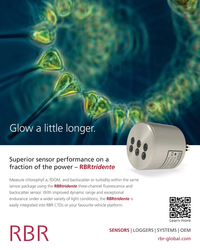 )
March 2024 - Marine Technology Reporter page: 4th Cover
)
March 2024 - Marine Technology Reporter page: 4th CoverGlow a little longer. Superior sensor performance on a rmance on a – – RBRtridentfraction of the power RBRtridente teee ackscatter or turbidity with hi i in n n t t th h h he e e s sa a am m m me Measure chlorophyll a, fDOM, and backscatter or turbidity within the same e e sensor package using the
-
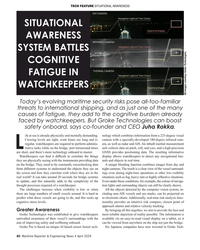 )
April 2024 - Maritime Reporter and Engineering News page: 40
)
April 2024 - Maritime Reporter and Engineering News page: 40are long and ir- camera with a specially-developed 180-degree infrared cam- regular, watchkeepers are required to perform adminis- era, as well as radar and AIS. An inbuilt inertial measurement L trative tasks while on the bridge, port turnaround times unit collects data on pitch, roll, and yaw, and a high-precisio
-
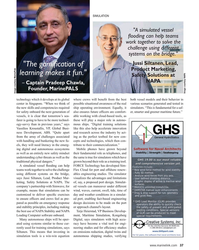 )
April 2024 - Maritime Reporter and Engineering News page: 37
)
April 2024 - Maritime Reporter and Engineering News page: 37SIMULATION "A simulated vessel ? ooding can help teams work together to solve the challenge using different systems on the bridge." – Jussi Siltanen, Lead, "The gami? cation of Product Marketing, learning makes it fun." Safety Solutions at NAPA – Captain Pradeep Chawla, Founder, MarinePALS Image
-
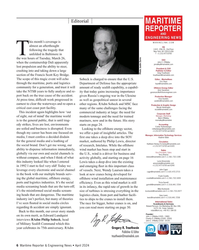 )
April 2024 - Maritime Reporter and Engineering News page: 6
)
April 2024 - Maritime Reporter and Engineering News page: 6Editorial MARITIME REPORTER AND ENGINEERING NEWS his month’s coverage is M A R I N E L I N K . C O M almost an afterthought HQ 118 E. 25th St., 2nd Floor following the tragedy that New York, NY 10010 USA T +1.212.477.6700 Tunfolded in Baltimore in the wee hours of Tuesday, March 26, CEO John C.
-
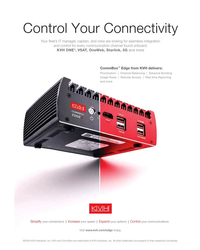 )
April 2024 - Maritime Reporter and Engineering News page: 5
)
April 2024 - Maritime Reporter and Engineering News page: 5Control Your Connectivity Your ?eet’s IT manager, captain, and crew are looking for seamless integration and control for every communication channel found onboard: ® KVH ONE , VSAT, OneWeb, Starlink, 5G and more ™ CommBox Edge from KVH delivers: Prioritization | Channel Balancing | Advance Bonding
-
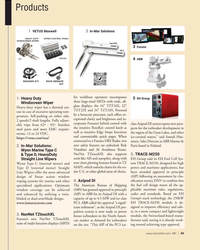 )
April 2024 - Marine News page: 43
)
April 2024 - Marine News page: 43Visualizer and AI Avoidance Route. Wynn Marine Type C NavNet TZtouchXL also supports & Type D, HeavyDuty 5. TRACE-M250 tools like AIS and autopilot, along with EH Group said its EH Fuel Cell Sys- Straight Line Wipers Wynn Type C (internal motor) and new chart plotting features found
-
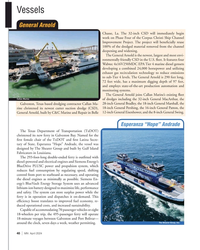 )
April 2024 - Marine News page: 40
)
April 2024 - Marine News page: 40Vessels General Arnold Chasse, La. The 32-inch CSD will immediately begin work on Phase Four of the Corpus Christi Ship Channel Improvement Project. The project will bene? cially reuse 100% of the dredged material removed from the channel deepening and widening. The General Arnold is the newest,
-
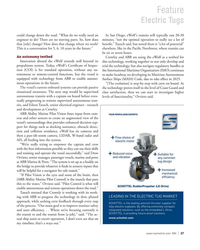 )
April 2024 - Marine News page: 37
)
April 2024 - Marine News page: 37such as docking assistance, obstacle detec- tion and collision avoidance. eWolf has six cameras and then a pan-tilt-zoom camera, LIDAR, W-band radar and AIS, all feeding into the system. “We’re really trying to empower the captain and crew with the best information possible so they can use their skills
-
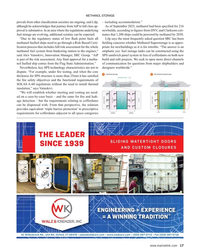 )
February 2024 - Maritime Reporter and Engineering News page: 17
)
February 2024 - Maritime Reporter and Engineering News page: 17METHANOL STORAGE provals from other classi? cation societies are ongoing, said Lilp, – including accommodation.” although he acknowledges that journey from AiP to full class ap- As of September 2023, methanol had been speci? ed for 216 proval is substantive. In an area where the regulations underlying
-
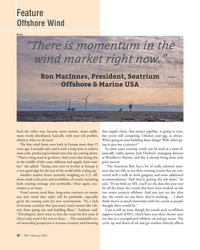 )
February 2024 - Marine News page: 30
)
February 2024 - Marine News page: 30of vessels, including accommodations. And they’re getting the job done,” he both existing tonnage and newbuilds. Once again, eco- said. “If you look on AIS, you’ll see the data this past year nomics is an issue. for all the Jones Act vessels that have been worked on the Vessel owners need ? rm, long-term
-
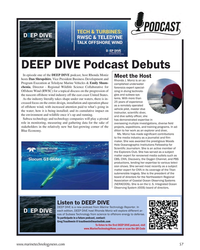 )
January 2024 - Marine Technology Reporter page: 57
)
January 2024 - Marine Technology Reporter page: 57DEEP DIVE Podcast Debuts In episode one of the DEEP DIVE podcast, host Rhonda Moniz Meet the Host hosts Dan Shropshire, Vice President Business Development and Rhonda J. Moniz is an ac- Program Execution at Teledyne Marine Vehicles & Emily Shum- complished underwater chenia, Director - Regional Wildlife
-
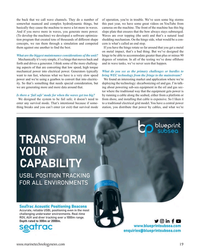 )
January 2024 - Marine Technology Reporter page: 19
)
January 2024 - Marine Technology Reporter page: 19the back that we call wave channels. They do a number of of operation, you’re in trouble. We’ve seen some big storms somewhat nuanced and complex hydrodynamic things, but this past year, we have some great videos on YouTube from basically they cause the machine to move a lot more in waves. cameras on
-
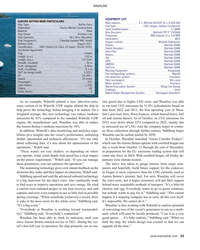 )
January 2024 - Maritime Reporter and Engineering News page: 33
)
January 2024 - Maritime Reporter and Engineering News page: 332020; Depth Sounders: Wärtsilä (SAM) Stockholm Agreement Auto Pilot: Wärtsilä (SAM) Flag: Finland Radios: Wärtsilä (SAM) Length, (o.a.): 150 m AIS: Wärtsilä (SAM) Length, (b.p.): 137.02m GPS: Wärtsilä (SAM) Breadth, (molded): 26 m GMDSS: Wärtsilä (SAM) Draft, (designed): 5.95m SatCom:
-
 )
January 2024 - Maritime Reporter and Engineering News page: 20
)
January 2024 - Maritime Reporter and Engineering News page: 20TECH FEATURE Figure 4. The vessel’s cargo holds feature Figure 5. The walls of the cargo holds All images courtesy of The Interlake Steamship Company ? at bottoms that accommodate the use bene? t from a zinc-based coating that of heavy machinery, which necessitated provides durability in an area
-
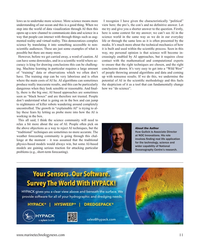 )
November 2023 - Marine Technology Reporter page: 11
)
November 2023 - Marine Technology Reporter page: 11lows us to undertake more science. More science means more I recognize I have given the characteristically “political” understanding of our ocean and this is a good thing. When we view here; the pro’s, the con’s and no de? nitive answer. Let step into the world of data visualization through AI then
-
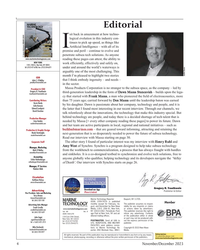 )
November 2023 - Marine Technology Reporter page: 4
)
November 2023 - Marine Technology Reporter page: 4Editorial sit back in amazement at how techno- logical evolution in this industry con- tinues to pick up speed, as things like I Arti? cial Intelligence – with all of its promise and peril – continue to evolve and penetrate subsea tech solutions. As anyone © Jason Adelaars MBARI 2023 www.marinetechnologyn
-
 )
December 2023 - Maritime Reporter and Engineering News page: 28
)
December 2023 - Maritime Reporter and Engineering News page: 28G REAT of HIPS S 2023 NSMV 1: EM mpire State VII is the ? rst in a series of ? ve Na- that there are two separate engine rooms with a pair of diesel tional Security Multi-Mission Vessel (NSMV), generators in each, both feeding dual high voltage switch- built at Philly Shipyard, powered by Wabtec
-
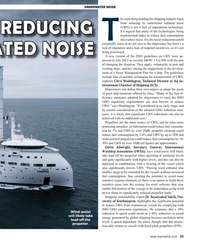 )
December 2023 - Maritime Reporter and Engineering News page: 25
)
December 2023 - Maritime Reporter and Engineering News page: 25UNDERWATER NOISE he main thing holding the shipping industry back from reducing its underwater radiated noise (URN) is not a lack of appropriate technology. It’s argued that many of the technologies being REDUCING implemented today to reduce fuel consumption T also reduce noise. So, the noise reduction
-
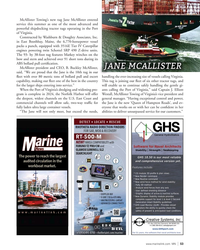 )
November 2023 - Marine News page: 53
)
November 2023 - Marine News page: 53McAllister Towing’s new tug Jane McAllister entered service this summer as one of the most advanced and powerful shipdocking tractor tugs operating in the Port of Virginia. Constructed by Washburn & Doughty Associates, Inc. in East Boothbay, Maine, the 6,770-horsepower vessel packs a punch, equipped
-
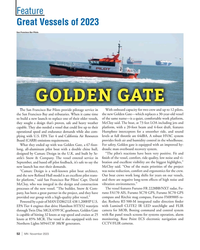 )
November 2023 - Marine News page: 52
)
November 2023 - Marine News page: 52. “The builder, Snow & Com- The vessel features Furuno FR 2228BB/NXT radar, Fu- pany, has been a great partner in the project, and they have runo FA170 AIS, Furuno SC70 GPS, Furuno SC70 GPS provided our group with a high-quality pilot vessel,” compass and Ritchie mag compass, Furuno FM8900S ra- Powered
-
 )
November 2023 - Marine News page: 49
)
November 2023 - Marine News page: 49R.B. WEEKS Eastern Shipbuilding Group Florida shipbuilder Eastern Ship- rier islands and nourishing beaches an electrical power, propulsion, and building Group (ESG) this Spring de- lost to erosion, aiding the U.S. Army dredge machinery package by Royal livered R.B. Weeks, a 8,550 cubic yard Corps of
-
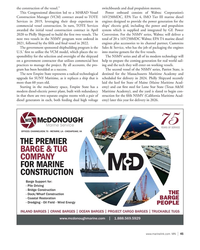 )
November 2023 - Marine News page: 45
)
November 2023 - Marine News page: 45the construction of the vessel.” switchboards and dual propulsion motors. This Congressional direction led to a MARAD Vessel Power onboard consists of Wabtec Corporation’s Construction Manager (VCM) contract award to TOTE 16V250MDC, EPA Tier 4, IMO Tier III marine diesel Services in 2019, leveraging
-
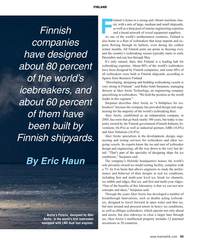 )
November 2023 - Maritime Reporter and Engineering News page: 45
)
November 2023 - Maritime Reporter and Engineering News page: 45FINLAND inland is home to a strong and vibrant maritime clus- ter, with a mix of large, medium and small shipyards, as well as a deep pool of marine engineering expertise F and a broad network of vessel equipment suppliers. Finnish As one of the world’s northernmost countries, Finland is also home to a
-
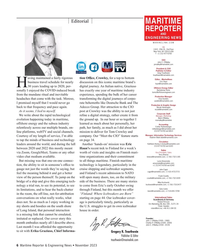 )
November 2023 - Maritime Reporter and Engineering News page: 6
)
November 2023 - Maritime Reporter and Engineering News page: 6Editorial MARITIME REPORTER AND ENGINEERING NEWS M A R I N E L I N K . C O M HQ 118 E. 25th St., 2nd Floor New York, NY 10010 USA T +1 212 477 6700 CEO John C. O’Malley [email protected] President & COO Publisher & Editor Greg Trauthwein [email protected] aving maintained a fairly rigorous
